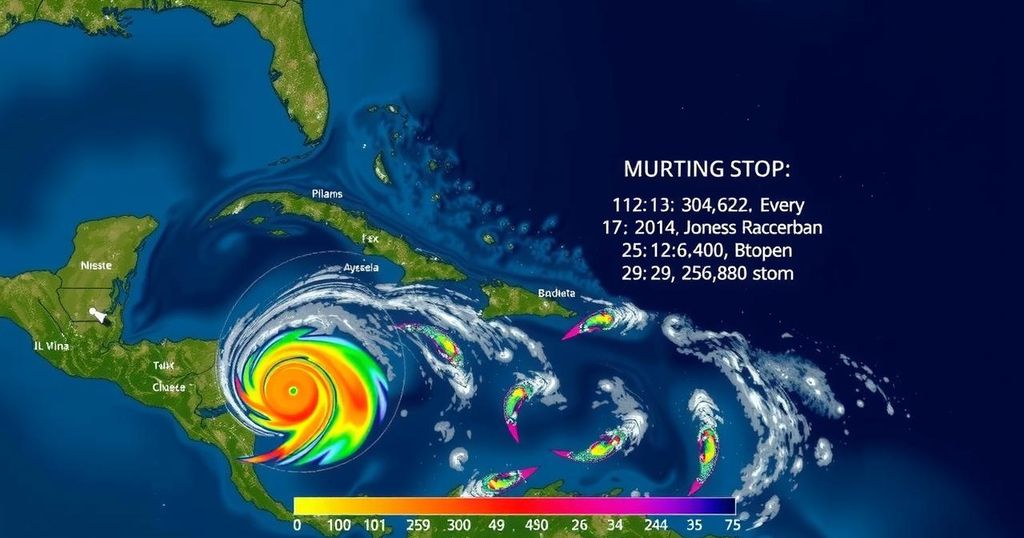2024 Atlantic Hurricane Season Displays Unprecedented Cyclonic Activity
The 2024 Atlantic hurricane season recorded 18 named storms, including 11 hurricanes and 5 major hurricanes, with substantial impacts along the U.S. coast. Noteworthy storms included Hurricane Beryl, the earliest Category-5 hurricane, Hurricane Helene, which resulted in over 150 fatalities, and Hurricane Milton, a significant late-season storm. Despite a lull in activity, the season concluded within expected ranges, emphasizing the critical role of NOAA’s forecasting capabilities.
The 2024 Atlantic hurricane season, which formally concludes on November 30th, has proven to be notably active, exhibiting a surge in storm activity following a typical lull during peak season. Throughout this season, the Atlantic basin recorded a total of 18 named storms, encompassing 11 hurricanes, five of which escalated to major hurricanes, reflecting activity levels that align with the forecasts provided by the NOAA’s Climate Prediction Center earlier in the year. Notably, five hurricanes impacted the continental United States, with two making landfall as major hurricanes.
A significant aspect of this season was the unusual pattern of storm formation, particularly with 12 named storms occurring post-September 25, marking an unprecedented resurgence for this timeframe. The early part of the season experienced a slowdown attributed to adverse environmental conditions over Western Africa, which hindered the development of tropical cyclones. NOAA officials, including Rick Spinrad, Ph.D., emphasized the importance of their research and forecasting efforts as essential means for communities and decision-makers to prepare for and respond to hurricanes.
Among the standout storms was Hurricane Beryl, the earliest recorded Category-5 hurricane in the Atlantic, which made landfall in Texas as a Category-1 storm, resulting in extensive storm surge flooding. Hurricane Helene, another catastrophic storm, struck the Florida Gulf Coast as a Category-4 hurricane, leading to significant flooding and damage across multiple states, recording over 150 fatalities, marking it one of the deadliest hurricanes since Katrina in 2005. Such severe impacts underscore the critical need for accurate forecasting and preparedness initiatives.
Hurricane Milton also made headlines, registering as one of the strongest late-season storms in the Gulf, resulting in a tornado outbreak and heavy rainfall causing localized flooding. The rapid intensification of Milton was striking, with wind speeds increasing drastically within a single day. This active season also benefited from technological advancements in forecasting, leading to improved prediction accuracy from the National Hurricane Center (NHC).
Looking ahead, as the agency compiles and evaluates the experiences of this year, they will assess feedback on new forecasting techniques used during the season. NOAA’s continuous advancements in modeling and observation have contributed significantly to storm research, ensuring enhanced preparedness for future hurricane seasons.
The Atlantic hurricane season typically peaks during a specific period of the year, with active cyclonic activity influenced by various environmental conditions. The National Oceanic and Atmospheric Administration (NOAA) routinely engages in comprehensive forecasting efforts, employing advanced technologies and methodologies to enhance the accuracy of storm tracking and prediction. The 2024 season illustrated these vectors through the examination of atmospheric conditions, allowing for strategic preparations against potential tropical cyclone threats. With a total of eight months in scope, hurricane season represents a crucial time for preparedness and response measures to be put into effect in vulnerable regions.
This hurricane season exemplified the necessity for continuous advancements in storm forecasting and preparedness, showcasing how changing climatic conditions impact hurricane activity. The NOAA’s proactive measures, technological enhancements, and dedicated research teams have proven vital in ensuring public safety during severe weather events. The 2024 season serves as a reminder of the unpredictability of hurricanes and stresses the importance of informed decision-making in the face of natural disasters.
Original Source: www.noaa.gov




Post Comment